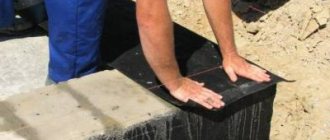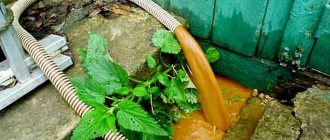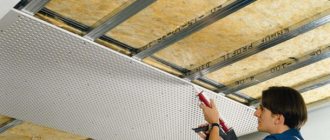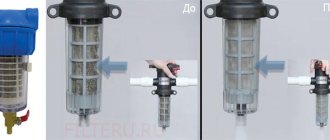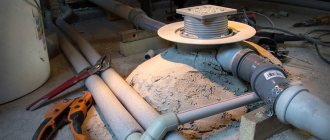Basements are a traditionally significant part of the house in Russia. The large area of the underground part of the house allows you to locate technical rooms there (laundry, workshop or even a home theater) or storage for household supplies. Separately equipped cellars also act as storage facilities.
In both winter and summer, it is very convenient to have free access to a cool, dark room with a uniform temperature, but then spring comes, the groundwater level rises, and not every basement or cellar remains dry. Quite often, leaks of varying sizes occur, their consequences also vary - from the appearance of dampness to complete flooding - but the results of this disaster are always the same: the basement can no longer be used, and serious damage to supplies and property is caused.
Even slight dampness in the basement is already a disaster. In a damp microclimate, mold and mildew actively develop, which harm people’s health, spoil things, and have a destructive effect on the floor and walls of the room.
Meanwhile, all of these problems could be avoided by properly sealing the basement to protect it from water. However, even after a flooded basement, not all is lost: it can be drained and repaired, and it will serve for many years to come.
Why does water appear in the basement?
The main and most dangerous source of water entering the basement is groundwater.
To protect against them, a drainage system is provided at the construction stage, and if the groundwater level is high or rises strongly in the spring, the house is built on a foundation made of a monolithic reinforced concrete slab. Therefore, it is so important to find out about the level of groundwater at the stage of design and construction of a house.
Another source is surface water from precipitation (rain, melted snow). To protect buildings from them, trenches are dug along the perimeter below the base of the basement, and pipes are laid in them to drain water. The structure is designed with a slight slope.
However, when the soil becomes saturated with moisture, the pressure increases, and this water begins to seep into the pores and cracks that are always present in concrete.
The absence or violation of the waterproofing system of the underground part of the structure is another of the main reasons for flooding and dampness in the basement.
Important!
Concrete is a very durable material, but it necessarily contains pores and capillaries into which water can enter. To increase water resistance, plasticizers and water repellents are added to concrete mixtures.
We advise you to study: Plasticizers for concrete
Even ordinary water is considered an aggressive liquid in relation to concrete: in the pores and cracks, after water enters, microorganisms (mold, bacteria) begin to multiply, the metabolic products of which destroy the concrete, and when freezing in winter, the water expands, and new microcracks appear in the concrete.
But groundwater is not just water, but, in fact, a solution of salts and acids, because in most regions of our country the soils are acidic to one degree or another.
Interesting!
If you live in an area with a lot of coniferous trees, the soil is probably acidic.
Solutions of salts and acids destroy concrete even faster than pure water. Small cracks become larger and larger, the material begins to crumble and loses its quality.
Flooding can also be caused by water or sewer pipes. Plumbing is not a force of nature; Eliminating and preventing pipe leaks is easier than dealing with groundwater.
Important!
It is necessary to take care of reliable drainage, ventilation and waterproofing of the basement at the stage of design and construction of the house. But it happens that a house is purchased or inherited ready-made. In this case, knowledge of how to get rid of water in the basement and waterproof the basement from groundwater from the inside will be useful.
How to dry a cellar after flooding
In addition to groundwater, dampness in the underground of a wooden house can also appear due to poorly organized ventilation. The first thing to do to eliminate a flood is to check the cleanliness of the ventilation ducts and, if necessary, clean them. If the ventilation is clean, but the dampness still does not go away, it means that the exhaust and air supply are designed or built incorrectly. All this happens when the air in the basement is colder than outside. As you know, heavy cold air will not flow up a special pipe on its own, which means forced ventilation is needed.
The main option for drying a basement, in this case, is to install a powerful exhaust fan and ensure the most comfortable conditions for the air entering the cellar. With this organization of air mass circulation, your cellar can dry out completely in a week.
There is also a “folk” way to dry a cellar - stimulating air movement using a candle. If it is impossible to use electrical appliances, you will have to slightly modify the configuration of the exhaust pipe (the one located under the ceiling). It needs to be extended to the floor, so that there is about fifteen centimeters left to it. A candle is placed in the resulting space, which is designed to heat the air in various pipe diameters, thereby creating draft. It happens that one candle is not enough for good traction; in this case, a burner is used.
In any case, be careful, make sure that this entire structure does not set fire to nearby objects!
How to isolate a basement from groundwater. Basement protection methods
To protect your home and basement from flooding, you need to provide high-quality waterproofing.
Today, there are three main methods of waterproofing a basement from groundwater:
- Anti-pressure. It is so called because it resists the pressure of water from the outside. This waterproofing is done on the outside of the building. It is usually recommended to do this if the groundwater level is higher than the floor level in the basement or cellar.
- Non-pressure. Protects mainly from rain and melt water. Recommended in case of deeper groundwater (lower than the basement floor).
- Anticapillary. This is protection against water penetration into cracks and capillaries in concrete, brick and other porous building materials. The traditional method is the use of bituminous materials, but there is a more modern and effective solution - the use of penetrating compounds. They are applied generously in one or several layers. Such compositions penetrate the pores and capillaries of concrete and cover it with a waterproof thin film that protects it from water.
Based on the method of performing the work, waterproofing can be divided into external and internal.
External waterproofing is carried out from the outside, which means that before starting work it is necessary to remove all the soil around the perimeter and clean the walls of dirt, and only after that begin waterproofing work:
- large cracks and crevices are sealed with cement-sand mortar;
- the walls are coated with bitumen mastic, onto which roll materials are glued;
- instead of bitumen, you can use penetrating compounds that are applied with a brush or roller in one or several layers;
- The materials dry within two days.
Important!
The waterproofing system should include waterproofing the foundation slab or basement floor.
Such protection works for 40–50 years, protecting the house from water penetration.
Internal waterproofing
This method of waterproofing allows you to renovate your basement with less labor; it is suitable if flooding has already occurred and the external waterproofing system has failed.
Important!
Waterproofing the basement from the inside works as part of a set of measures, including drainage and ventilation.
In this case, modern materials such as the cement-based dry mixture WaterPlug CEMMIX are suitable for reliable sealing of active leaks.
This mixture is diluted with cold water to obtain a plastic mass from which a filling can be made.
A distinctive feature of the WaterPlug mixture is its ability to harden quickly, which makes it suitable for repair work with active leaks.
External drainage
Along the entire perimeter of the future structure, it is necessary to dig drainage trenches about 40 cm wide, preferably 20-30 cm below the proposed base.
It is necessary to dig trenches at a slight slope so that the water drains faster, and to make digging easier and the bottom does not wash away, you need to dig so that the shovel goes towards the flow of water.
Then, at the bottom of the trench, a compacted sand cushion is created, which is covered with geotextile to prevent mixing of layers.
It is important to remember that some inexpensive types of geotextiles conduct water in only one direction, which must coincide with the direction of water flow in the trenches.
Larger drainage material in the form of pebbles, expanded clay or crushed stone is laid on top of the geotextile.
Special drainage pipes made of asbestos or polymers, equipped with holes on top or on all sides, are laid in prepared trenches and connected into a single system.
The number of trenches and the size of the pipes must correspond to the amount of water in direct proportion. Pipes with one-sided perforation are laid with the holes down.
If there is too much groundwater, then it is likely that at the place of its main exit from the drainage pipe system it is necessary to dig a special reservoir into which it will flow during a flood or after rains, and then seep out of it back into the ground.
The storage tank will also have to be protected from the soil sliding with geotextiles, concrete walls or a large plastic container.
When filling drainage trenches with pipes, the operation is repeated: first sand, then geotextiles, then gravel.
The area under the bottom of the cellar is leveled with gravel. The advantage of external drainage is that it removes water before it reaches the structure, but requires a little more excavation.
Universal Cleaner
Moss and mold cleaner for walls, floors and roofs (concentrate)
Read more
In addition, it has the following advantages:
- works underwater;
- hardening time - from 1.5 to 5 minutes;
- has high adhesion to various materials;
- can be used for both external and internal work;
- it is environmentally friendly, which means it can be used without a doubt in private homes, in basements intended for storing food;
- vapor permeable;
- waterproof;
- frost-resistant;
- durable;
- economical;
- allows operation in the temperature range from +5°C to +30°C.
WaterPlug CEMMIX dry mix is easy to purchase in retail stores, for example, the Leroy Merlin chain or wholesale from the manufacturer.
Without pump
If a problem arises, how to pump out a single flood of water from a cellar without using a pump, you can use a vibration pump.
Important! When the basement is repeatedly flooded, the pump is pumped and a pump becomes necessary to pump water out of the cellar.
The problem of basements flooding with water is relevant. There are several methods for dealing with moisture. It is necessary to combat flooding, because a foundation buried under water can collapse, and this will negatively affect the condition of the entire structure.
Materials and tools necessary for waterproofing the basement from groundwater from the inside
Proper waterproofing is carried out on the side of exposure to an aggressive environment (water) to protect building materials from destruction as a result of getting wet.
But it is not always possible to dig out walls, and especially floors, under a building, which is why technologies for waterproofing rooms from the inside have been developed.
To do this, you will need waterproofing materials, for example, Universal, which is mixed with water before work, after which the entire surface of the walls and floors is coated with it.
Important requirements for the surface before application: no moving cracks in the structure. If there are any, they must be insulated with ClearFixa elastic material.
In the case of particularly critical structures, pressure walls and an additional layer of concrete on the floor are installed to the waterproofing layer. Such a system is called a “pinched” or, in accordance with accepted construction terminology, a “sandwich system.”
Tools that will be useful are a mixing container and spatulas for applying the mixture, as well as personal protective equipment (gloves, goggles, respirator).
Ventilation device
Ventilation is necessary so that moisture does not accumulate inside the cellar.
For vegetable stores, the creation of a standard microclimate is mandatory. There should be no stagnant odor or drafts in the room.
Ventilation creates conditions:
- supplies fresh air;
- provides the required temperature;
- regulates humidity.
They make a system for inflow and outflow of flows. Air ducts can be round or rectangular. The supply pipe is placed at the bottom, at a level of 60 cm from the floor surface. The hood is brought to the roof of the cellar and raised by 1 m. Two pipes are placed in diagonally opposite corners to increase draft.
How to make internal waterproofing of basement walls. Step-by-step instruction
Let's look at the basic steps of arranging basement waterproofing.
Step 1: Removing water
If the basement is flooded with water, then at the first stage the water is removed by manually scooping it out or pumping it out using a pump.
Step 2. Drying
The room needs to be dried. The capillary flow of water through the structures is stopped by rubbing the WaterPlug dry mixture manually in a circular motion until the flow of moisture stops.
Step 3. Filling the floor
In a basement after flooding, it is often advisable to re-flood the floor. The old base is cleaned of dirt and loosely bound particles and treated with Universal waterproofing mixture, then a concrete screed is made. To ensure a strong and high-quality screed, the way the concrete mixture is prepared is of great importance.
It is possible to lay the mixture well without special equipment if it has a flexible consistency, but such a consistency is usually associated with excess water content, which ultimately does not have the best effect on the strength of concrete.
Adding a plasticizer to the mixture allows you to save up to 15% of cement, do without excess water and at the same time obtain a mobile, self-laying mixture and strong, dense concrete. For a basement, it is especially important that the concrete be dense, with a small number and small diameter of pores. Such concrete is less prone to getting wet. The plasticizer allows you to reduce the number and diameter of pores in concrete and obtain a dense, water-resistant screed.
Also, at the screed manufacturing stage, it is advisable to use water-repellent additives and impregnations for concrete, which give them water-repellent properties.
We advise you to study: Water repellents for concrete
Step 4: Treating the Basement Walls
The walls are cleaned of dirt and all cracks are sealed with cement-sand mortar, and then treated with Universal waterproofing mixture or special waterproofing impregnations.
Important!
What to do if you find water in the basement of a private house? For emergency repairs, use seals made from the dry mixture WaterPlug CEMMIX, which allows repairs even during a leak, even under water. A hydraulic seal made from a dry mixture is, in fact, also concrete, but not simple, but waterproofing. Therefore, it can be used not only in places of active leakage, but also where the possibility of its occurrence is expected.
Prevention of re-flooding
To avoid re-flooding, you need to waterproof the basement after draining . The materials used depend on the characteristics of the room. If its walls were made of concrete, it is necessary to use a special impregnation that penetrates deep into its structure.
Roofing felt has good waterproofing properties. It can be used to cover the floor in the basement. Sheets of roofing felt are laid on top of mastic, which itself has insulating properties.
Universal Cleaner
Moss and mold cleaner for walls, floors and roofs (concentrate)
Read more
How to protect your basement from dampness:
- During new construction, do not be lazy to carry out reconnaissance work to find out the depth of groundwater. Design a quality drainage system, basement ventilation, and waterproofing.
- If the house is not new, and groundwater lies close to the surface, install a drainage system around the perimeter and carry out external and internal waterproofing work.
- If you are not sure where the leak is coming from, apply a coating of Universal waterproofing mixture to the entire doubtful area.
- If water appears in the basement, the dry mixture WaterPlug CEMMIX and Universal waterproofing mixture, which have proven themselves well with various materials, will help to urgently eliminate the leak.
Tips for using WaterPlug CEMMIX dry mix:
- If there is an active leak in a large area, make a dovetail cutout, place a seal in it and press it down with a block. after this the flow will stop.
- If there are several sources of leakage, start treating from the top of the wall, gradually moving down.
- WaterPlug CEMMIX can also be used underwater. You'll plug the leak and then deal with the problem of draining and then waterproofing the basement.
If the basement or cellar leaks, this is not a reason to stop using it. Using modern materials, you can quickly eliminate leaks or overhaul your basement and continue to use it, saving money on the construction of a new basement. Water repellents and dry mixtures WaterPlug and Universal from CEMMIX will help you make high-quality and reliable repairs.
You can buy WaterPlug CEMMIX without leaving your home, with discounts from 5 to 33%!!!!
Buy on Ozon
Buy on Yandex.Market
Buy on Wildberries
Buy at Leroy Merlin
Or you can find the nearest official dealer in your region on our map
← How to use waterproof silicone and polyurethane sealants
Cladding of buildings: why do you need brick on the facade →
Return to list
Comments
What are they pumping out with?
Pumped out from the cellar using automatic pumps.
Automatic pumps are:
- submersible – placed in a liquid;
- external - its upper part is on the surface, its lower part is under water.
On the website you can find a layout diagram of the automatic water pumping system.
Installation algorithm:
- in the center of the basement a recess is made for a tank - a caisson. The caisson is needed to accumulate moisture;
- for better protection they are wrapped in geotextiles;
- install the pump in the tank;
- after filling, the pump turns on automatically;
- after pumping it turns off.
Read more: how to use a pump to pump water out of a basement.
The easiest way to pump out water is with a pump
News
We are always ready to help
Cemmix has opened a free hotline
to help you with any questions related to construction using concrete additives. Call and ask, our consultants are always ready to help!
Hyperplasticizer
Hyperplasticizers are a new type of plasticizing additives for concrete, ensuring the mobility of the mixture above P5. In addition to plasticity, they increase the water resistance and frost resistance of concrete by 2-3 times.

